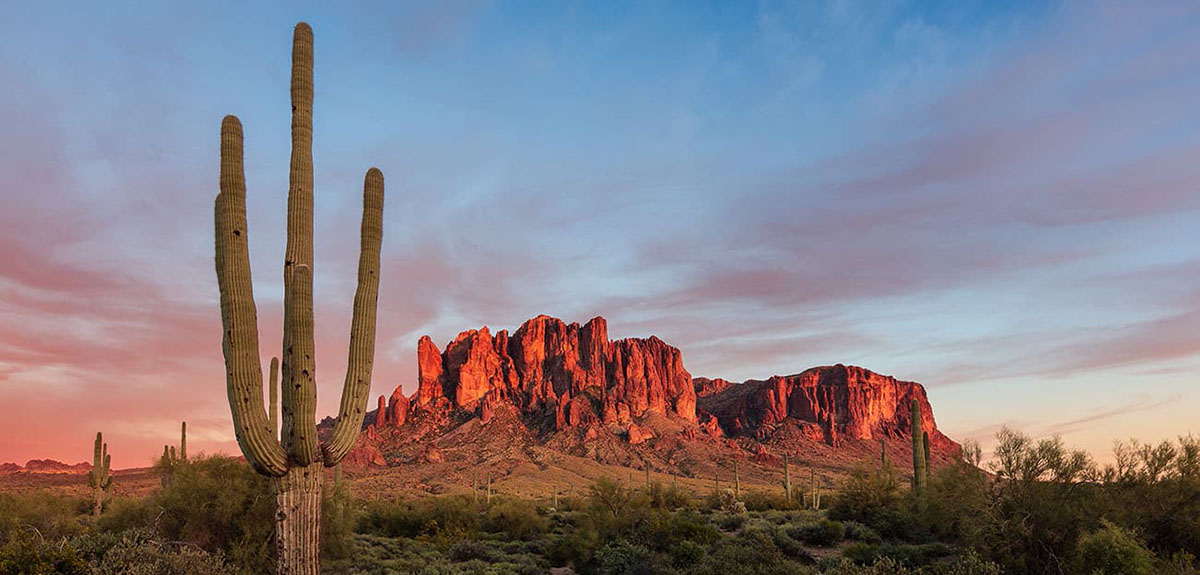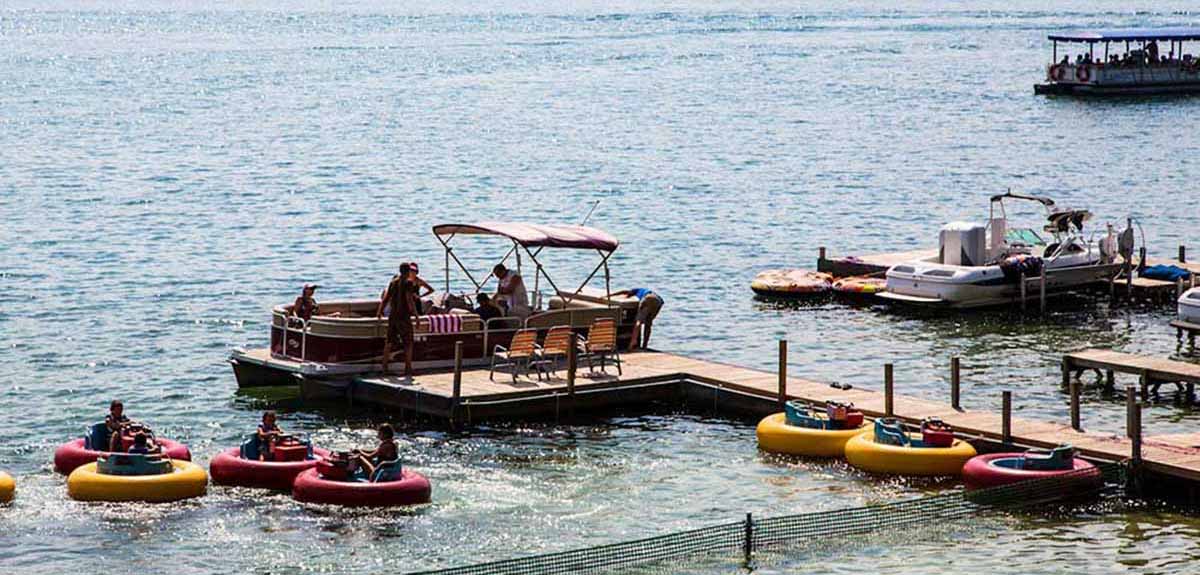RVing in North Carolina’s Outer Banks
Image Caption:
In 1587, at the request of Queen Elizabeth I, 117 brave English pioneers landed on Roanoke Island on the Outer Banks of North Carolina to establish a permanent settlement in the New World. The most famous resident of the colony, Virginia Dare, was born that year, the first English birth on the continent. Shortly after her birth, her grandfather, John White, governor of the colony, sailed back to England for supplies. When he returned three years later, the colonists had vanished without a trace, except for the word “Croatoan” carved into the side of a building and “CRO” carved into a nearby tree.
Did the Croatoan, an Algonquin Indian tribe in the area, adopt the settlers or kill them? What became of Virginia Dare and the others remains a mystery, but the location where they briefly settled now draws visitors from around the country. Some are intrigued by the legend of what has been dubbed the Lost Colony, but most come for the sandy beaches, historic lighthouses, saltwater fishing and a myriad of other outdoor activities. Virginia’s last name, Dare, sums up the possibilities. One can be as daring as one wishes, starting with dinner.
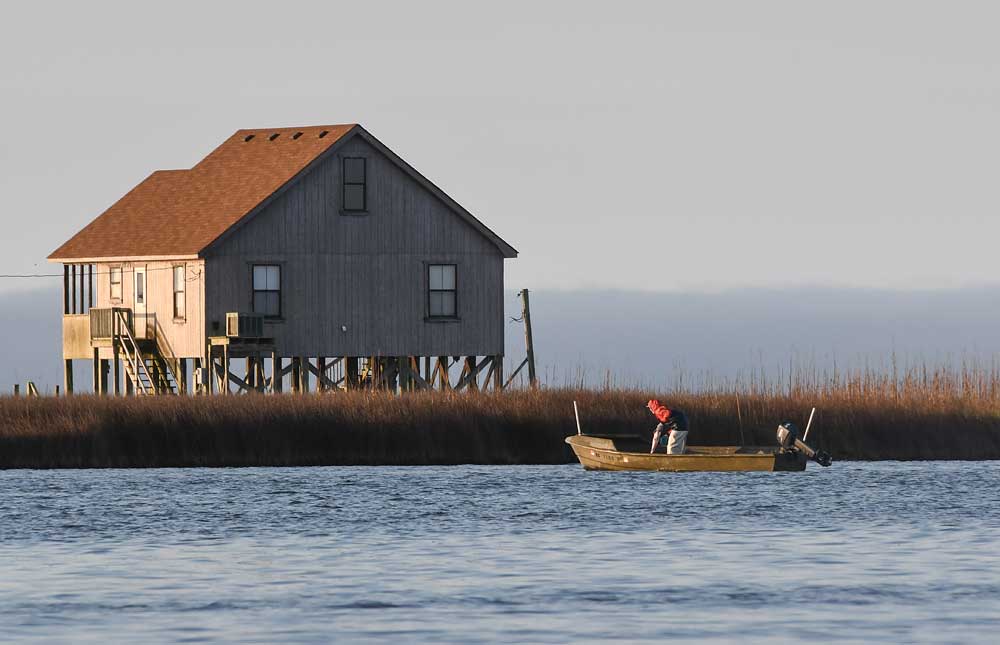
BUILT ON STILTS: A local commercial fisherman pulls a bluefish from his nets. The fish was caught near a “duck house,” a salt-marsh dwelling on stilts used for waterfowl hunting in the fall. PHOTOS: LISA AND JACK BALLARD
Soft Crabs
My husband, Jack, and I had a long list of things we wanted to do, but after a day of driving, eating was our first priority. We turned north on State Highway 12, the main artery of this long, skinny string of islands, passing through Nags Head. In the next town, Kill Devil Hills, we found a local diner, the Kill Devil Grill. The parking lot was full. We figured it had to be good.
“Two Kill Devils and soft crabs,” stated the waitress, as if it were a foregone conclusion.
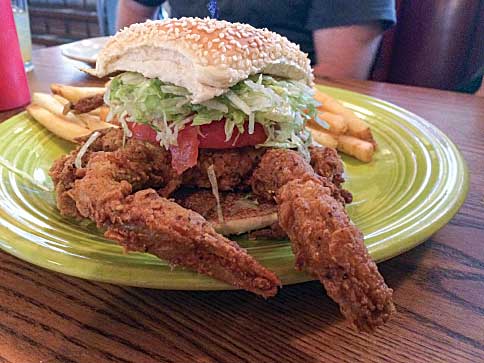
CULINARY ADVENTURE: “Soft crab” is a seasonal delicacy in the Outer Banks. When blue crabs molt, foodies feast on these tasty crustaceans — the whole thing! The author sampled this one at the Kill Devil Grill.
We stared blankly at her. We had never heard of a Kill Devil. We assumed “soft crabs” was local lingo for “soft-shelled crabs.” The thought of eating a crab, shell and all, did not sound appetizing. As I was about to ask for a menu, a man in the booth next to us leaned over.
“Kill Devil is the local rum,” he translated. “It’s so strong, it would kill the devil. You gotta try it!”
“Are ‘soft crabs’ soft-shelled crabs?” I asked.
“Blue crabs,” he replied, “They’re molting right now.
The fishermen are working 24-7 while they shed their shells. The crabs double
in size if they stay wet. It’s a huge delicacy in the area.”
The waitress returned 15 minutes later and placed burger buns and cocktails in front of Jack and me. Batter-crisped crab claws extended beyond the edge of the buns. I lifted the top off mine, revealing the whole crab, head and all.
“If you’ve never had it before, it’s best to start with the deep-fried sandwich,” said the waitress, as she turned to walk away.
I’m not usually daring when it comes to unusual food, but I figured the Kill Devil rum drink would summon my brave blood.
“When in Rome…” I said to Jack, taking a bite.
“You mean, the Outer Banks,” he replied.
Outer Banks History
The Outer Banks is a mecca for all kinds of outdoor recreation, especially on the water. Hatteras is world-famous among windsurfers and kite sailors for its steady wind, but we prefer calmer pursuits, especially on the water.
The next morning we joined a kayaking tour of the Kitty Hawk Woods Coastal Reserve, a canal through a maritime forest, marshes and swamplands.
Built in the 1800s when logging and fishing were the main occupations here, the canal was used to drift logs into a central collection area. Today, it’s a quiet place to paddle away from the crashing surf and bustle of Nags Head and Kitty Hawk.
The flora was fascinating, especially the black needlerush, with its stiff, pointed leaves that the Lost Colonists purportedly used for sewing. Our guide also pointed out duck potato, a tuberous aquatic plant that ducks, geese and muskrats eat, and, unfortunately, invasive phragmites, an aggressive, tall grass that releases toxins from its roots, allowing it to take over the areas where it grows.
We passed under the only covered bridge on the Outer Banks, then the canal became narrower and overgrown. After a mile and a half, we turned around. On the way back, Jack spotted a yellow-bellied slider that allowed us to get inches away. The turtle was the daring one this time.
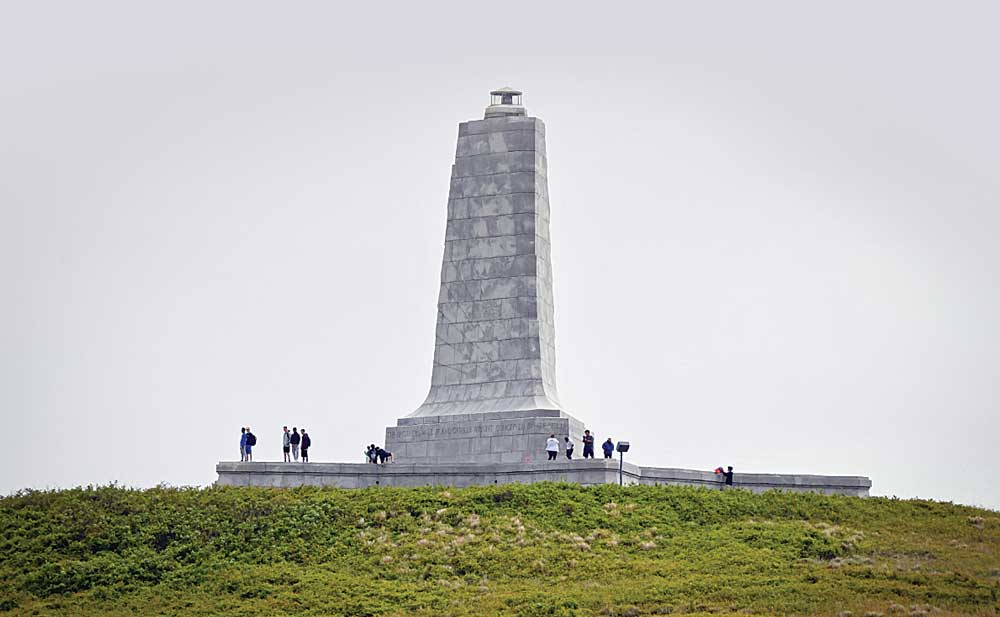
The Wright Brothers National Memorial, atop Kill Devil Hill, commemorates the accomplishments of aviation pioneers Wilbur and Orville.
First in Flight
Going to the Wright Brothers National Memorial is a must-do for anyone visiting the Outer Banks. In fact, it was my fascination with their first flight that drew us there.
In December 1903, Orville shook hands with his brother, Wilbur, then laid down on their motor-driven experimental aircraft. His flight lasted only 12 seconds and went only 120 feet at an average speed of 6.8 miles per hour, but how it changed the world! For the first time, a manned, heavier-than-air machine had left the ground under its own power and landed at an elevation equal to where it started.
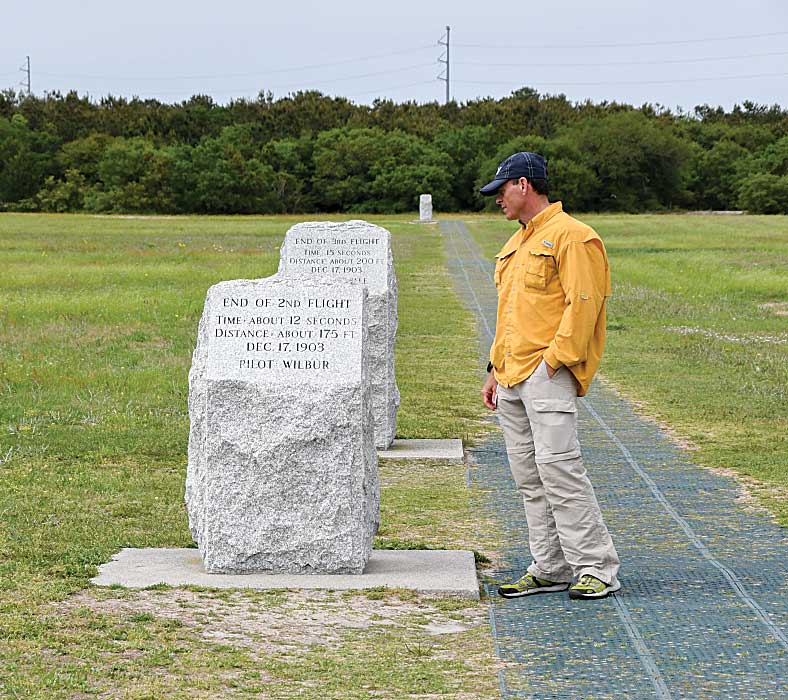
Engraved stones mark the brothers’ historic landing points.
The memorial sits atop Kill Devil Hill, the dune upon which Wilbur and Orville launched their experimental gliders more than 1,000 times prior to their first successful powered flight.
We climbed to the top of the dune to see the memorial. It offered a sweeping view of the ocean to the east, but the expansive field below us, to the north, drew our gaze. It was easy to imagine the Wrights taking off from this high point and landing somewhere below us with one of their gliders. That said, the dune was not where their famous powered flight took place. That was at the far end of the field.
We descended the dune, then walked the half mile from the memorial to a boulder, marking the Wright brothers’ takeoff point. There were four markers past the boulder, one for each of their flights that historic day. Orville may have gone first, but Wilbur went the farthest, 852 feet on the last attempt. We’ve visited many historic sites over the years, but few had the impact of standing at the very site where mankind first flew under his own power and control.
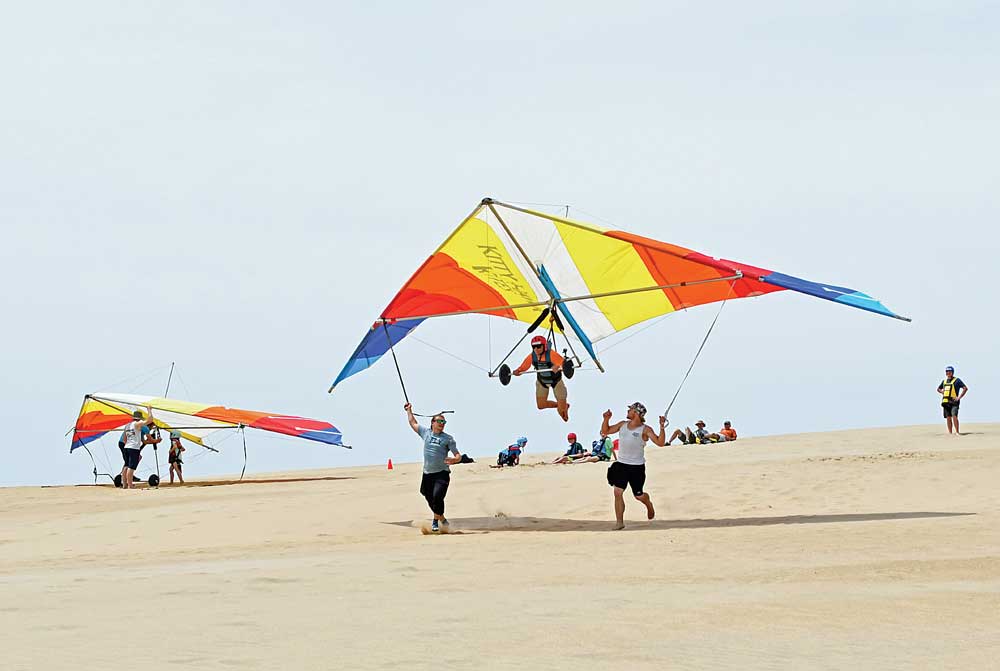
A visitor takes off on his first hang-gliding flight with help from Kitty Hawk Kites instructors. The Wright brothers made 1,000-plus test flights at Kitty Hawk using hang gliders, prior to their famous inaugural powered flight.
Flying High
The Wright brothers came to Kitty Hawk to test their fliers for two key reasons: steady winds and sand dunes. The dunes provided excellent launching points and soft landings. I unexpectedly caught the flying bug after seeing where they had soared.
For my entire adult life, I swore I would never go hang-gliding, but two hours after seeing the Wright Brothers National Memorial, I was lying atop a 100-foot dune, strapped to a kite, with my heart beating out of my chest. The largest hang-gliding school in the country, Kitty Hawk Kites, is located in Jockey’s Ridge State Park in Nags Head. More than 400,000 people have learned to fly there since 1974.
“Ready?” asked Wolf, my instructor who held the left wing-tip of my glider. Another instructor held the right one.
“You bet,” I said confidently, though my brain screamed, “No!”
The two instructors started running down the dune. Instantly, I was in the air 5, then 10, then 15 feet high.
“Flare!” yelled Wolf.
I dutifully raised the front edge of my glider, and gently landed on my feet on the sand. My first flight lasted 12 seconds, the same as Orville Wright’s.
I wondered who had felt more adrenaline, him or me. I made five flights that day. As I prepared for the last one, Wolf asked me what I wanted to do.
“Go as far as I can!” I replied, pointing to a lone tuft of grass at the far end of the landing zone. I was no longer afraid. Once aloft, I applied what little skill I had acquired to keep the oversize kite in the air as long as possible. As my feet touched the sand a few feet past the tuft of grass, I smiled back at Wolf, who gave me a thumbs-up.
Fishing in the Outer Banks
The next morning brought a different type of adrenaline rush, the kind that comes from catching a fish for the first time. At dawn, we got back in kayaks and paddled onto a large sheltered bay near Whalebone Junction. The water was framed by acres of marsh grass to our left and right. We followed the grass on the left, passing a couple of deserted duck-hunting cabins. Interestingly, the town just north of Kitty Hawk is named Duck. Tourists originally came here to go duck hunting in the early 1900s, and it’s still a draw in the fall.
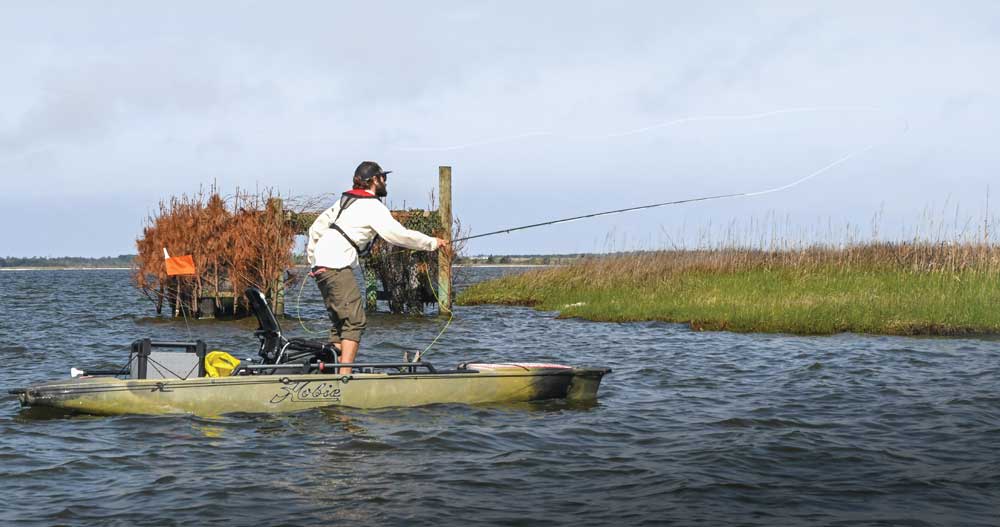
An angler casts for redfish near a permanent duck blind beside a salt marsh.
A commercial fisherman in a small tin boat smiled as we paddled by, but there was no wave. His hands busily untangled a large bluefish from his net. We had fly rods, though fly-fishing is not common here due to the winds. We were lucky. It was a rare calm morning. After putting a reasonable distance between our kayaks and the tin boat, we began casting toward the grass, hoping to hook a striped bass or a redfish.
We worked our way up one side of the bay, then down the other. Nothing. We blamed the water, which was a chilly 55 degrees, 10 degrees colder than optimal for fishing. A massive fog bank bore down on us. I was just about to give up when I felt a tug at the end of my line and set the hook. The strike felt more of a thud than a wiggle. Maybe it was a big fish. It certainly got spunkier the longer I played it. When it finally came to my net, it took a moment to figure out what it was.
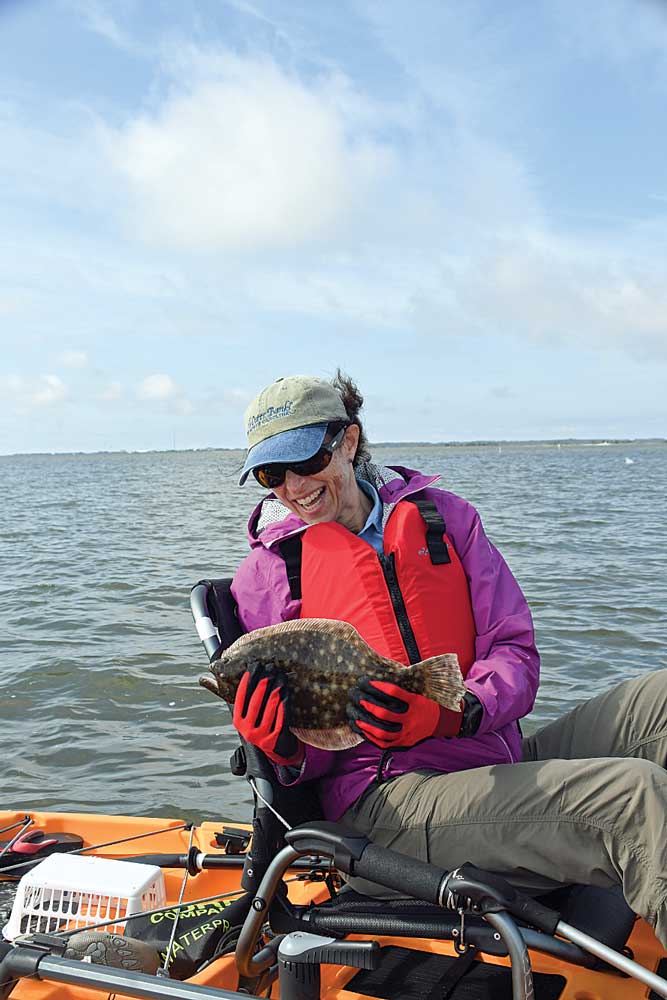
The author, Lisa Ballard, holds her first flounder catch.
My first flounder!
I had never seen a live flounder before and couldn’t figure out how to hold it at first. It was the oddest-looking fish I had ever landed, a flat disc surrounded by fins, with both eyes on one side of its body.
That evening, we brought it to Basnight’s Lone Cedar Cafe in Nags Head where they’ll cook the fish you catch. As we watched two ospreys tend to their nest just outside the large seaside windows by our table, I had a revelation. Locals frequently use the acronym “OBX,” rather than writing “Outer Banks.” I wondered if the “X” had a second meaning: “extreme.” This had sure been an adrenaline-packed stopover, and a memorable one at that.
What to Know Before You Go to the Outer Banks
The Outer Banks is a 200-mile-long series of barrier islands covering most of the North Carolina coastline and accessible by ferry or two bridges. Much of it remains wild, thanks in part to Cape Hatteras National Seashore and Pea Island National Wildlife Refuge, which begin just south of Whalebone Junction at the heart of the Outer Banks. Because of the unique geographical locale, the region has unusual weather patterns and a subtropical climate.
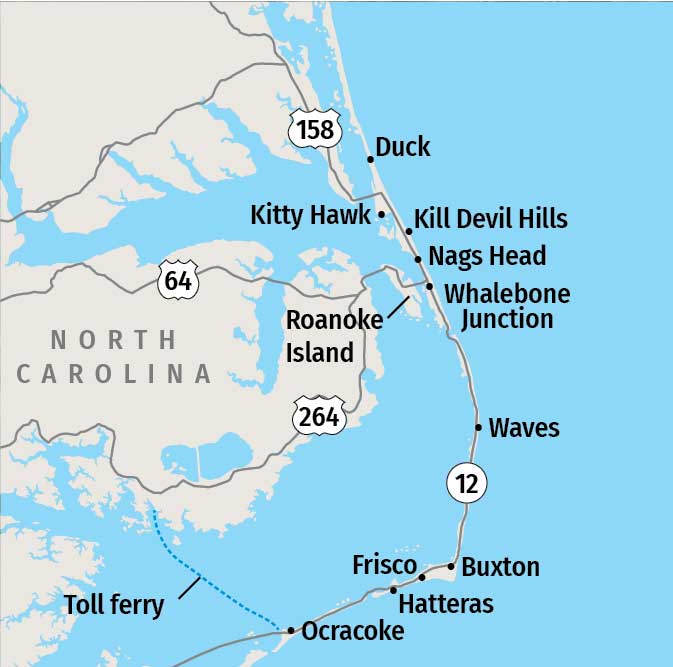
• July and August are the high season. Be sure to have a campground reservation in advance of your trip.
• May, June, September and October are less crowded, though temperatures can be chilly.
• Arrive by bridge if possible. If you’re planning to take a ferry, make a reservation. The ferries are usually full. If you don’t have a reservation, especially for a large RV, you may have to wait many hours for a spot on the boat.
• Fireworks are not allowed on the Outer Banks.
• Not all campgrounds allow campfires. Call ahead if that’s part of your evening plans.
• Bring bug spray, especially if your campsite is in a wooded area or near a salt marsh.
• Stock up on groceries and other supplies. The farther you camp from the main towns, the fewer (or none) the shopping options.
Pirates of the Outer Banks
During the 17th and 18th centuries, a number of infamous pirates such as Captain Kidd and Edward “Blackbeard” Teach frequently pillaged colonies and ships along North Carolina’s Outer Banks. The town of Nags Head is so named because pirates placed a light on a nag (horse) on the beach. Unsuspecting ships thought the light signaled a break in the barrier islands. When they ran aground, the pirates trapped everyone aboard and stole their cargo and valuables.
Blackbeard was particularly prominent among the pirates prowling the Outer Banks. He was eventually caught and beheaded. Some say his body still swims around Teach’s Hole in Ocracoke in search of his head. On a clear night, the glimmering moonlight on the water is called Teach’s Lights. Local legend says if you follow the lights to the end, you’ll find Blackbeard’s treasure.
Pirates were the outlaws of the ocean. They lived dangerous lives, though most did not die fighting to take over other ships. They lost their lives mainly from food poisoning, starvation and disease. Most were vitamin C deficient, which caused blindness. That’s why many wore eye patches. They also wore gold or silver earrings, believing precious metals would help them see better. And they never made their enemies walk the plank. That’s a Hollywood fabrication. Real pirates simply threw their victims overboard.
Historic Lighthouses
Five lighthouses have long warned ships of the dangerous shoals and guided them through the narrow channels of the Outer Banks’ barrier islands. Today, these safety beacons are national historic landmarks and among the highlights of any visit to this coastal playground.
Bodie Island Lighthouse
Built: 1872

